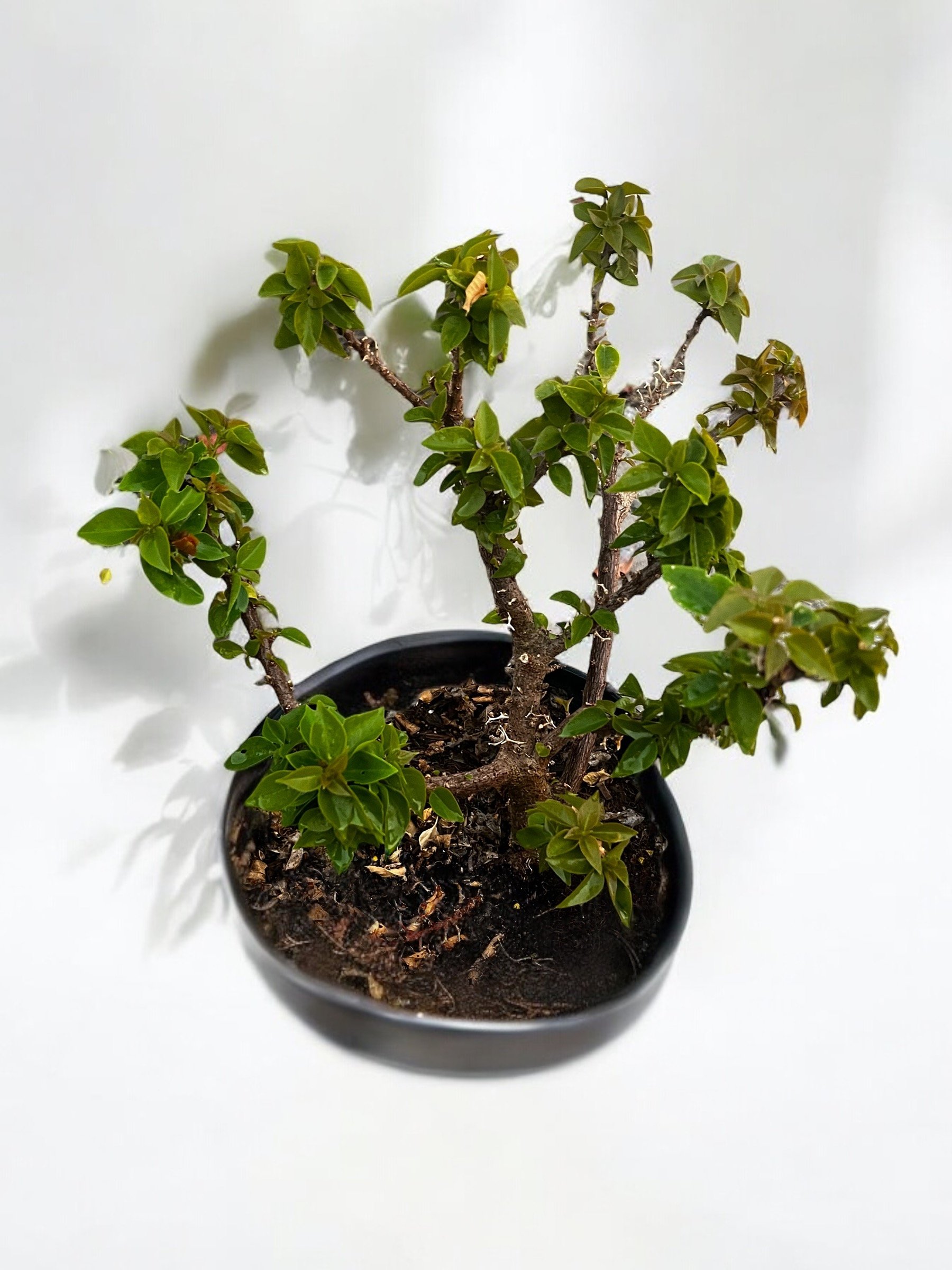Bougainvillea Bonsai 25 Years Old | Unique & Rare Varieties
Bougainvillea Bonsai 25 Years Old | Unique & Rare Varieties| Unique & Rare Varieties
The Bougainvillea r Bonsai Tree is a genus of thorny ornamental vines, bushes, and trees.Tree consist of large colorful septal-like bracts. Native to Brazil, Bolivia, Paraguay, Peru, and Argentina. In In Feng Shui, Bougainvillea’s vibrant color symbolizes energy inspire action, determination, and personal growth, and fueling one's journey towards self-improvement. It’s also known to be considered an auspicious plant : Acts as a protector.
Product Includes:
Bougainvillea Bonsai Tree (as seen in image, pot is not included)
Shipping plant bare rooted
Care Instruction
How To Care:
Light: Thrives in direct bright sunlight
Watering: Allow the soil to dry out completely between waterings. Overwatering can lead to root rot. Water less in winter, as the plant's growth slows down.
Soil: Prefers well-draining succulent or cactus soil. You can also mix regular potting soil with sand or perlite for better drainage.
Pruning: Late Winter or early Spring after the main blooming season. By pruning will encourage new growth and more blooms. Remove dead and damaged branches. Trim back the tips of the plant.
Temperature: Ideal range is between 60-75°F (15-24°C). It can handle slight drops in temperature but avoid frost.
Fertilizing: During the growing season (spring and summer), feed with a diluted, balanced succulent fertilizer once a month. No need to fertilize in the winter.
Hardiness: Hardy in USDA zones 9-10, and its drought tolerance makes it ideal for warm climates year-round. They are semi-hardy to frost when young and are suited to a subtropical to tropical climate. Can tolerate temperatures as long as they don't drop below 32°F
Toxicity: The sap can cause serious skin rash
What to expect:
The plant you receive will be similar to the one listed for sale. While there may be slight variations due to natural growth patterns, we ensure that each plant is carefully selected to match the quality and appearance shown in the listing.
1. Initial Inspection: Carefully unpack your plant and inspect it 2. Rest Period: Allow your succulent to rest for a few days before watering or repotting. This helps it acclimate to its new environment. Place it in a well-lit, airy spot, but avoid direct sunlight initially to prevent sunburn.
3. Watering: Wait at least a week before watering your new plant. Ensure the soil is completely dry before the first watering.
4. Repotting: Repotting it into a well-draining mix. This will provide better conditions for growth.
5. Acclimation: Gradually introduce your plant to more sunlight. Start with indirect light and slowly move it to a brighter spot over a week or two.
6. Ongoing Care: Plants thrive with minimal care. Ensure they get plenty of light, water sparingly, and keep an eye out for any signs of stress or pests.
Bougainvillea Bonsai 25 Years Old | Unique & Rare Varieties| Unique & Rare Varieties
The Bougainvillea r Bonsai Tree is a genus of thorny ornamental vines, bushes, and trees.Tree consist of large colorful septal-like bracts. Native to Brazil, Bolivia, Paraguay, Peru, and Argentina. In In Feng Shui, Bougainvillea’s vibrant color symbolizes energy inspire action, determination, and personal growth, and fueling one's journey towards self-improvement. It’s also known to be considered an auspicious plant : Acts as a protector.
Product Includes:
Bougainvillea Bonsai Tree (as seen in image, pot is not included)
Shipping plant bare rooted
Care Instruction
How To Care:
Light: Thrives in direct bright sunlight
Watering: Allow the soil to dry out completely between waterings. Overwatering can lead to root rot. Water less in winter, as the plant's growth slows down.
Soil: Prefers well-draining succulent or cactus soil. You can also mix regular potting soil with sand or perlite for better drainage.
Pruning: Late Winter or early Spring after the main blooming season. By pruning will encourage new growth and more blooms. Remove dead and damaged branches. Trim back the tips of the plant.
Temperature: Ideal range is between 60-75°F (15-24°C). It can handle slight drops in temperature but avoid frost.
Fertilizing: During the growing season (spring and summer), feed with a diluted, balanced succulent fertilizer once a month. No need to fertilize in the winter.
Hardiness: Hardy in USDA zones 9-10, and its drought tolerance makes it ideal for warm climates year-round. They are semi-hardy to frost when young and are suited to a subtropical to tropical climate. Can tolerate temperatures as long as they don't drop below 32°F
Toxicity: The sap can cause serious skin rash
What to expect:
The plant you receive will be similar to the one listed for sale. While there may be slight variations due to natural growth patterns, we ensure that each plant is carefully selected to match the quality and appearance shown in the listing.
1. Initial Inspection: Carefully unpack your plant and inspect it 2. Rest Period: Allow your succulent to rest for a few days before watering or repotting. This helps it acclimate to its new environment. Place it in a well-lit, airy spot, but avoid direct sunlight initially to prevent sunburn.
3. Watering: Wait at least a week before watering your new plant. Ensure the soil is completely dry before the first watering.
4. Repotting: Repotting it into a well-draining mix. This will provide better conditions for growth.
5. Acclimation: Gradually introduce your plant to more sunlight. Start with indirect light and slowly move it to a brighter spot over a week or two.
6. Ongoing Care: Plants thrive with minimal care. Ensure they get plenty of light, water sparingly, and keep an eye out for any signs of stress or pests.
